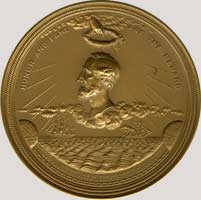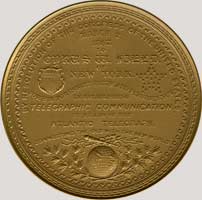
PREV ARTICLE
NEXT ARTICLE
FULL ISSUE
PREV FULL ISSUE
J. GOLDSBOROUGH BRUFF, NUMISMATIST, ARTIST, MEDAL DESIGNER
Several readers responded to my query about the numismatic work of J. Goldsborough Bruff. Thanks - this is some great stuff on Bruff.
-Editor
First to respond (at midnight Sunday!) was none other than Q. David Bowers himself, whose book "American Numismatic Association Centennial History" inspired my query. He forwarded text on Bruff from his book "A California Gold Rush history: Featuring the Treasure from the S.S. Central America". Here's an excerpt.
J. Goldsborough Bruff, captain of the Washington City & California Mining Association, created one of the more elaborate journals of any Forty-Niner. In fact, he created multiple diaries and sketchbooks, sometimes overlapping. Bruff was a numismatist, as reflected by the contents of his estate, which included a copy of Montroville W. Dickeson's impressive American Numismatical Manual, published in 1859. As to whether he followed the hobby in the days of '49 the present writer does not know. However, he is the only Forty-Niner known to us who described an Indian peace medal being worn by its recipient. April 30, 1849. Monday. Ke-ro-ich, a Nemahaw half-chief, came into camp. He wore a silver medallion with bust of president Van Buren on it. A drunken emigrant several days afterwards, jerked it off his neck, and kept it the greater part of a day, but had to restore it on the old chief kicking up a rumpus—threatening to look out for the emigrant when he should cross the river and pass through their country. David Gladfelter writes: Bruff (1804-1889) was a “topographical draftsman and amateur artist” who worked for a federal engineering agency. During the gold rush he went to California, where he organized the California Mining Association. He kept an illustrated journal, which was published in 1944. From 1876 until his death, he worked for the Office of the Supervising Architect in the Treasury Department. There is more in Groce and Wallace, "The New-York Historical Society's Dictionary of Artists in America 1564-1860". This book answers many basic questions about U.S. die sinkers and engravers in the period before 1860. The late Bob Lindesmith recommended this source book to me many years ago, when we were writing articles about token and medal engravers and die sinkers. I have used it in numismatic research many times. You should be able to find it in most public or college libraries. Dick Johnson writes: Cornelius Vermeule must have seen the same document Dave Bowers mentioned in his A.N.A. Centennial History. Vermeule mentions Bruff on page 51 in his Numismatic Art in America. Joseph Goldsborough Bruff was one of the most difficult artists on which to obtain any sustentative biographical data. Even Joseph Florimond Loubat, with the vast resources he must have had at his disposal to compile his magnificent 2-volume masterpiece, The Medallic History of the United States, 1776-1876, had only 3 lines on Bruff! Loubat cast a very wide net. He did not capture much on Bruff. Bruff designed only one medal -- the 1868 Cyrus West Field Medallion, Julian PE-10, Loubat 77 (also Storer, Massachusetts, 1924). There was one of these medals in the David Dreyfus auction April 12, 1986, by Bowers & Merena and Presidential Coin & Antique. I sold one in a CAL auction, and Joe Levine has sold at least two more in his auction sales (I have not recorded all his auction sales in my databank yet, there may be more). Below is a part of the entry on Bruff from my databank on American Coin and Medal Artists. Incidentally, I have made the decision to place this on the Internet for all to access instead of publishing this in a hardback book. I hope to accomplish this in 2010.
BRUFF, Joseph Goldsborough (1804-1889) American amateur artist, topographical draftsman; as employee of Treasury Department he designed one medal. Born Washington, DC, 2 October 1804. Vermeule stated Bruff prepared sketches for an eagle intended for a U.S. coin; the design pleased chief engraver James Longacre who preserved the sketches and may have influenced his design of the 1849 U.S. double eagle but he is not credited for this. Huntington Library, San Marino, California, has three paintings by this artist, all western U.S. scenes. Died Washington, DC, 14 April 1889.
Dick Johnson referenced the Groce and Wallace book.
Field's accomplishment was the creation of the first transatlantic telegraph cable connecting the U.S. and England. The Cyrus Field medal is described in detail in R.W. Julian's Medals of the U.S. Mint, the first century, 1792-1892.
The entry has been published online at a site devoted to the history of the Atlantic Cable. Here are some excerpts.
-Editor


The Field medal is singular in nature because it was awarded twice, something a little out of the ordinary for Congressional medals. Perhaps the intrepid Field, for all the troubles he had gone through from the elements and business rivals, deserved more than one medal. After the Congressional resolution of March 2, 1867, matters were to move rather quickly. Joseph Goldsborough Bruff of the Treasury Department, who prepared the original design, finished it by late July and within a few days it was on the way to the mint. (He was Supervising Architect of the Treasury Department at that time.) Although Bruff produced a fairly detailed drawing for his design, William Barber, then an assistant engraver, asked for a sitting with Field in New York so that the likeness might be as perfect as possible. In September, 1867, Barber went to New York and carefully sketched Field. Barber returned quickly to the mint and began work on the proper models. For more information, see: atlantic-cable.com/Field/medal.htm Michael Paradis found a wonderful lithograph print by Bruff in a February 15, 2006 auction by Dorothy Sloan—Rare Books: “Bruff, an accomplished artist, organized a company which traveled overland to the gold region in 1849-50. The letter refers to their trials and tribulations, as well as to the projected publication of Bruff 's notes and drawings on his arduous trip.” This inimitable lithograph is entertaining, utterly captivating, and highly clever. Many meanings are indicated by charming phonic pictures rather than spelled words, such as the dateline for Washington City, with a miniature view of the city of Washington, D.C., the word “of ”, and a bust portrait of George Washington. Bruff 's lively art work and wonderful sense of humor shine at their best in his rebus letter. There is such an immediacy and fluidity of line in the letter it is difficult to believe it was engraved on the stone in reverse.

For more information, see: Bruff's Rare Rebus Letter (www.dsloan.com/Auctions/A16/lot_016.html)
John Lupia forwarded an extensive file on Bruff. Thanks! Here are some excerpts with information not covered above.
-Editor
He was born on October 2, 1804 in Washington, D. C., son of Thomas Bruff, a physician. He went to West Point from 1820-1822 studying as a topographical engineer. He was dismissed from West Point in 1822 supposedly because of his involvement in a duel. He was orphaned at the time of his dismissal since his mother died the previous April 14, curiously, the same day of his own death in 1889. From 1822 to 1827 he worked as a cabin boy sailing to British and Netherlandish port cities and throughout South America. He produced many maps used by the United States government during the Mexican War and the Civil War. Finally, he worked as a draftsman for the architects, Ammi Burnham Young and Isaiah Rogers, for the Treasury Department from 1853-1869, where designed architectural ornaments for the south and west wings, and other Treasury facilities around the country. Rogers's successor, Alfred Bult Mullett apparently did not like him and restricted his work, inducing him to leave at the end of June in 1869. He left to serve in the Treasury Register's office until September in 1876. On 16 October 1876 he received another appointment as draftsman in the office of the Supervising Architect, James G. Hill, of the Treasury Department. Hill's successor, Will A Feret also did not like him, citing him five times on tardiness for one a half minutes and five minutes in 1885. He remained in his post until his final illness in 1889. He was a numismatist collecting Ancient Coins and kept a cabinet. He died April 14, 1889 at Washington, D.C. and is buried in the National Congressional Cemetery.
Tardiness of one and a half minutes? Now that's harsh. But Bruff sure led an interesting life and left a great legacy in his journals and artwork. Thanks everyone, for all the great information.
-Editor
To read the earlier E-Sylum article, see:
QUERY: J. GOLDSBOROUGH BRUFF
(www.coinbooks.org/esylum_v13n19a08.html)
The Numismatic Bibliomania Society is a non-profit organization promoting numismatic literature. See our web site at coinbooks.org. To submit items for publication in The E-Sylum, write to the Editor at this address: whomren@gmail.com To subscribe go to: https://my.binhost.com/lists/listinfo/esylum All Rights Reserved. NBS Home Page Contact the NBS webmaster 
|